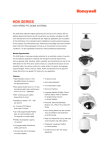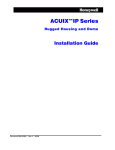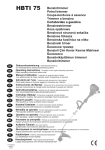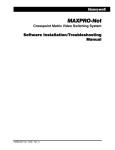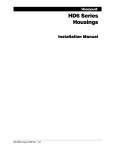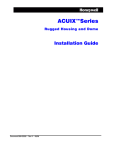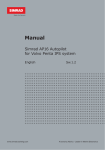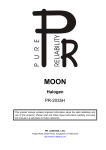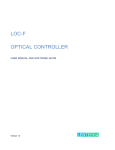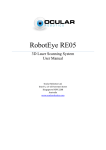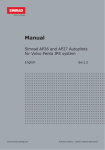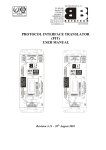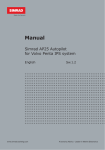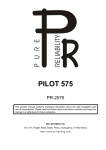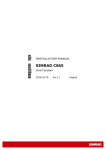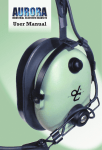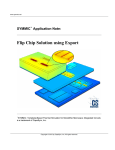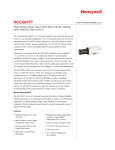Download HD6 Pressurized Dome Installation Manual
Transcript
HDT0E000 HDT0E003 HDT0E00A HD6 Nitrogen Pressurized Dome Installation Manual 900.0725 – June 2006 - Rev. 1.0 ISSUE DATE REVISIONS 900.0697 1.0 December 2005 Initial Release 900.0725 1.0 Rev. 1.0 June 2006 Add installation drawings for fly-lead configuration; remove drawings for 28-pin configuration; add ground connection to 14-pin connector configuration; Add IP66 rating; remove Ultradome; change CAT5 to UTP; delete UTC; added 23x color and 25x day/night camera models ii 900.0725 21-June-06 FCC COMPLIANCE STATEMENT INFORMATION TO THE USER: This equipment has been tested and found to comply with the limits for a Class A digital device, pursuant to part 15 of the FCC rules. These limits are designed to provide reasonable protection against harmful interference when the equipment is operated in a commercial environment. This equipment generates, uses, and can radiate radio frequency energy and, if not installed and used in accordance with the instruction manual, may cause harmful interference to radio communications. Operation of this equipment in a residential area is likely to cause harmful interference in which case the user will be required to correct the interference at his own expense. CAUTION: Changes or modifications not expressly approved by the party responsible for compliance could void the user’s authority to operate the equipment. This Class A digital apparatus complies with Canadian ICES-003. Cet appareil numérique de la Classe A est conforme à la norme NMB-003 du Canada. USERS OF THE PRODUCT ARE RESPONSIBLE FOR CHECKING AND COMPLYING WITH ALL FEDERAL, STATE, AND LOCAL LAWS AND STATUTES CONCERNING THE MONITORING AND RECORDING OF VIDEO AND AUDIO SIGNALS. HONEYWELL VIDEO SYSTEMS SHALL NOT BE HELD RESPONSIBLE FOR THE USE OF THIS PRODUCT IN VIOLATION OF CURRENT LAWS AND STATUTES. Rev. 1.0 iii 900.0725 21-June-06 Rev. 1.0 iv 900.0725 21-June-06 IMPORTANT SAFEGUARDS 1. READ INSTRUCTIONS – All safety and operating instructions should be read before the unit is operated. 2. RETAIN INSTRUCTIONS – The safety and operating instructions should be retained for future reference. 3. HEED WARNINGS – All warnings on the unit and in the operating instructions should be adhered to. 4. FOLLOW INSTRUCTIONS – All operating and use instructions should be followed. 5. CLEANING – Unplug the unit from the outlet before cleaning. Do not use liquid cleaners or aerosol cleaners. Use a damp cloth for cleaning. 6. ATTACHMENTS – Do not use attachments not recommended by the product manufacturer as they may result in the risk of fire, electric shock, or injury to persons. 7. WATER AND MOISTURE – Ensure the pressurized dome is sealed so water and moisture cannot penetrate the mount, the housing, or lower dome. The electronic pan and tilt device housed in the dome cannot be exposed to water or moisture. 8. ACCESSORIES - Do not place this product on an unstable cart, stand, tripod, bracket, or table. The product may fall, causing serious injury to a child or adult and serious damage to the equipment. Use only with a cart, stand, tripod, bracket, or table recommended by the manufacturer, or sold with the product. Any mounting of the product should follow the manufacturer’s instructions and should use a mounting accessory recommended by the manufacturer. Wall or shelf mounting should follow the manufacturer’s instructions and should use a mounting kit approved by the manufacturer. 9. A product and cart combination should be moved with care. Quick stops, excessive force, and uneven surfaces may cause the product and cart combination to overturn. 10. VENTILATION - Slots and openings in the cabinet and the back or bottom are provided for ventilation and to ensure reliable operation of the equipment and to protect it from overheating. These openings must not be blocked or covered. The openings should never be blocked by placing the product on a bed, sofa, rug, or other similar surface. Equipment should never be placed near or over a radiator or heat register. This product should not be placed in a built-in installation, such as a bookcase or rack unless proper ventilation is provided or the manufacturer’s instructions have been adhered to. 11. POWER SOURCES – This product should be operated only from the type of power source indicated on the marking label. If you are not sure of the type of power supplied to your home, consult your product dealer or local power company. For products designed to operate from battery power or other sources, refer to the operating instructions. 12. GROUNDING OR POLARIZATION – The power supply supplied with this unit may be equipped with a polarized alternating-current line plug (a plug having one blade wider than the other). This plug will fit into the power outlet only one way. This is a safety feature. If you are unable to insert the plug fully into the outlet, try reversing the plug. If the plug should still fail to fit, contact your electrician to replace your obsolete outlet. Do not defeat the safety purpose of the polarized plug. Rev. 1.0 v 900.0725 21-June-06 IMPORTANT SAFEGUARDS, CONTINUED 13. OVERLOADING – Do not overload outlets and extension cords as this can result in a risk of fire or electric shock. 14. POWER-CORD PROTECTION – Power supply cords should be routed so that they are not likely to be walked on or pinched by items placed upon or against them, paying particular attention to cords and plugs, convenience receptacles, and the point where they exit from the monitor. 15. OBJECT AND LIQUID ENTRY – Never push objects of any kind into this unit through openings as they may touch dangerous voltage points or short-out parts that could result in a fire or electric shock. 16. SERVICING – Do not attempt to service this unit yourself as opening or removing covers may expose you to dangerous voltage or other hazards. Refer all servicing to qualified service personnel. 17. DAMAGE REQUIRING SERVICE – Unplug the unit from the outlet and refer servicing to qualified service personnel under the following conditions: a. When the power-supply cord or plug is damaged. b. If liquid has been spilled, or objects have fallen into the unit. c. If the electronic unit housed in the dome has been exposed to rain or water. d. If the unit does not operate normally by following the operating instructions. Adjust only those controls that are covered by the operating instructions as an improper adjustment of other controls may result in damage and will often require extensive work by a qualified technician to restore the unit to its normal operation. e. If the unit has been dropped or the enclosure has been damaged. f. When the unit exhibits a distinct change in performance - this indicates a need for service. 18. REPLACEMENT PARTS – When replacement parts are required, be sure the service technician has used replacement parts specified by the manufacturer or have the same characteristics as the original part. Unauthorized substitutions may result in fire, electric shock or other hazards. 19. SAFETY CHECK – Upon completion of any service or repairs to this unit, ask the service technician to perform safety checks to determine that the unit is in proper operating condition. 20. LIGHTNING AND POWER LINE SURGES – For added protection of this unit during a lightning storm, or when it is left unattended and unused for long periods of time, unplug it from the wall outlet and disconnect the control system. This will prevent damage to the unit due to lightning and power-line surges. 21. HEAT – The product should be situated away from heat sources such as radiators, heat registers, stoves, or other products (including amplifiers) that produce heat. 22. WALL OR CEILING MOUNTING – The product should be mounted to a wall or ceiling only as recommended by the manufacturer Rev. 1.0 vi 900.0725 21-June-06 EXPLANATION OF GRAPHICAL SYMBOLS The lightning flash with arrowhead symbol within an equilateral triangle is intended to alert the user to the presence of uninsulated "dangerous voltage" within the product's enclosure that may be of sufficient magnitude to constitute a risk of electric shock to persons. The exclamation point within an equilateral triangle is intended to alert the user to the presence of important operating and maintenance (servicing) instruction in the literature accompanying the product. CAUTION CAUTION RISK OF ELECTRIC SHOCK DO NOT OPEN CAUTION: TO REDUCE THE RISK OF ELECTRIC SHOCK, DO NOT REMOVE COVER (OR BACK). NO USER-SERVICEABLE PARTS INSIDE. REFER SERVICING TO QUALIFIED SERVICE PERSONNEL. WARNING WARNING: TO REDUCE THE RISK OF FIRE OR ELECTRIC SHOCK, DO NOT EXPOSE TH E ELECTRONIC PAN AND TILT UNIT TO RAIN OR MOISTURE. WARNING: DO NOT INSERT ANY METALLIC OBJECT THROUGH VENTILATION GRILLS THIS PRODUCT TO RAIN OR MOISTURE. WARNING: THIS UNIT MUST BE PROPERLY GROUNDED. NON-OBSERVANCE OF THIS STANDARD PRACTICE MAY RESULT IN A STATIC ELECTRICITY BUILD-UP THAT MAY RESULT IN AN ELECTRIC SHOCK WHEN EXTERNAL CONNECTIONS ARE TOUCHED. Rev. 1.0 vii 900.0725 21-June-06 Notes: Rev. 1.0 viii 900.0725 21-June-06 TABLE OF CONTENTS SECTION 1: INTRODUCTION .................................................................................................................. 1 1.1 MODELS ....................................................................................................................................... 1 1.2 SYSTEM REQUIREMENTS........................................................................................................... 3 1.3 HANDLING PROCEDURES .......................................................................................................... 3 1.3.1 Lower Domes ................................................................................................................... 3 1.3.2 Scan Assemblies.............................................................................................................. 4 1.3.3 Camera Lens.................................................................................................................... 4 1.4 REQUIRED INSTALLATION TOOLS AND ACCESSORIES .......................................................... 5 1.5 RECOMMENDED CABLING AND CONNECTORS....................................................................... 5 SECTION 2: INSTALLATION .................................................................................................................... 7 2.1 MOUNTING................................................................................................................................... 7 2.2 INSTALLATION ............................................................................................................................. 7 SECTION 3: TROUBLESHOOTING PROCEDURES .............................................................................. 17 3.1 GENERAL ................................................................................................................................... 17 3.2 REMOVING THE HD6 SCAN FROM THE PRESSURIZED DOME ............................................. 20 SECTION 4: MAINTENANCE.................................................................................................................. 21 4.1 PREVENTIVE MAINTENANCE.................................................................................................... 21 4.1.1 Cleaning the Clear Lower Dome.................................................................................... 21 4.1.2 Cleaning the Camera Lens ............................................................................................ 21 SECTION 5: PARTS ................................................................................................................................ 23 5.1 DRAWINGS AND PARTS LISTINGS ........................................................................................... 23 SECTION 6: SPECIFICATIONS .............................................................................................................. 27 Rev. 1.0 ix 900.0725 21-June-06 LIST OF FIGURES AND TABLES Figure 1. HD6 PRESSURIZED DOME INSTALLATION (FLY-LEADS/NO CONNECTOR) ........................... 9 Figure 2. HD6 PRESSURIZED DOME INSTALLATION (14-PIN CONNECTOR)........................................ 10 Figure 3. HD6 PRESSURIZED DOME WITH UNSHIELDED TWISTED PAIR (UTP) OPTION INSTALLATION (FLY-LEADS) ..................................................................................................... 11 Figure 4. JUMPER SETTINGS STANDARD HD6 UNITS ........................................................................... 13 Figure 5. JUMPER SETTINGS AND DIP SWITCH SETTING FOR HD6 UNITS WITH UTP OPTION......... 13 Figure 6. SCREW TIGHTENING PATTERN ............................................................................................... 15 Table 1. TROUBLESHOOTING PROCEDURES ........................................................................................ 17 Rev. 1.0 x 900.0725 21-June-06 SECTION 1: INTRODUCTION 1.1 MODELS Model Number Description HD6AE1N1 HD6 with 18X Color Camera (NTSC) in Pressurized Dome with Smoked Lower Dome, Standard firmware, no connector HD6AE1NJ HD6 with 18X Color Camera (NTSC) in Pressurized Dome, UTP interface, with Smoked Lower Dome, Standard firmware, no connector HD6AE1NA HD6 with 18X Color Camera (NTSC) in Pressurized Dome with Smoked Lower Dome, Standard firmware, 14-pin connector HD6AE4N1 Same as HD6AE1N1 except has a clear lower dome. HD6AE4NJ Same as HD6AE1NJ except has a clear lower dome. HD6AE4NA Same as HD6AE1NA except has a clear lower dome. HD6BE1N1 HD6 with 18X Day/Night Camera (NTSC) in Pressurized Dome with Smoked Lower Dome, Standard Firmware, no connector HD6BE1NJ HD6 with 18X Day/Night Camera (NTSC) in Pressurized Dome, UTP interface, with Smoked Lower Dome, Standard firmware, no connector HD6BE1NA HD6 with 18X Day/Night Camera (NTSC) in Pressurized Dome with Smoked Lower Dome, Standard firmware, 14-pin connector HD6BE4N1 Same as HD6BE1N1 except has a clear lower dome. HD6BE4NJ Same as HD6BE1NJ except has a clear lower dome. HD6BE4NA Same as HD6BE1NA except has a clear lower dome. HD6CE1N1 HD6 with 23X Day/Night Camera (NTSC) in Pressurized Dome with Smoked Lower Dome, Standard Firmware, no connector HD6CE1NJ HD6 with 23X Day/Night Camera (NTSC) in Pressurized Dome, UTP interface, with Smoked Lower Dome, Standard firmware, no connector HD6CE1NA HD6 with 23X Day/Night Camera (NTSC) in Pressurized Dome with Smoked Lower Dome, Standard Firmware, 14-pin connector HD6CE4N1 Same as HD6CE1N1 except has a clear lower dome. HD6CE4NJ Same as HD6CE1NJ except has a clear lower dome. HD6CE4NA Same as HD6CE1NA except has a clear lower dome. HD6DE1N1 HD6 with 23X Color Camera (NTSC) in Pressurized Dome with Smoked Lower Dome, Standard Firmware, no connector HD6DE1NJ HD6 with 23X Color Camera (NTSC) in Pressurized Dome, UTP interface, with Smoked Lower Dome, Standard firmware, no connector HD6DE1NA HD6 with 23X Color Camera (NTSC) in Pressurized Dome with Smoked Lower Dome, Standard Firmware, 14-pin connector Rev. 1.0 1 900.0725 21-June-06 1.1 MODELS, CONTINUED Model Number Description HD6DE4N1 Same as HD6DE1N1 except has a clear lower dome. HD6DE4NJ Same as HDDCE1NJ except has a clear lower dome. HD6DE4NA Same as HDDCE1NA except has a clear lower dome. HD6EE1N1 HD6 with 25X Day/Night Camera (NTSC) in Pressurized Dome with Smoked Lower Dome, Standard Firmware, no connector HD6EE1NJ HD6 with 25X Day/Night Camera (NTSC) in Pressurized Dome, UTP interface, with Smoked Lower Dome, Standard firmware, no connector HD6EE1NA HD6 with 25X Day/Night Camera (NTSC) in Pressurized Dome with Smoked Lower Dome, Standard Firmware, 14-pin connector HD6EE4N1 Same as HD6EE1N1 except has a clear lower dome. HD6EE4NJ Same as HD6EE1NJ except has a clear lower dome. HD6EE4NA Same as HD6EE1NA except has a clear lower dome. If the model number has a P in the seventh digit (e.g. HD6AE1P1), the unit has a PAL Camera. Rev. 1.0 2 900.0725 21-June-06 1.2 SYSTEM REQUIREMENTS • A basic HD6 pressurized system consists of the following items. Housing HD6 scan with camera and lens Lower dome Power Supply with Surge Suppression such as the TR-24/WSP This whole assembly is often referred to as a "dome". The pan and tilt assembly with camera and lens is often referred to as a "scan". • One of the following types of mounting arrangements. DWM-19 Outdoor Wall Mount DPM-19 Outdoor Pendant Mount PRM-100 Outdoor Parapet Roof Mount • Controller • Monitor The system can also contain other types of interface equipment such as a video switcher or a control output expander. Refer to the specific equipment manuals for installation. 1.3 HANDLING PROCEDURES No item should be removed from its shipping container for any prolonged period of time until it is ready for permanent installation. All handling of equipment outside of its protective packaging must be performed with utmost care. Any installation of equipment not accomplished by Honeywell personnel must be accomplished in strict accordance with these procedures so as not to void any warranty provisions. 1.3.1 Lower Domes The lower domes are all acrylic plastic. A dome has an optical surface through which a camera must resolve detailed images. It is extremely important to treat the units with the same care as you would a fine camera lens. It is important to prevent the domes from being scratched. Rev. 1.0 3 900.0725 21-June-06 1.3 HANDLING PROCEDURES, CONTINUED WARNING: For Warranty Protection, Please Read The Following Paragraphs Carefully. A. Always handle the dome from the outside of its circular flange. B. Use dry air pressure or any nonabrasive cleaning cloth and cleaning agent safe for use on acrylic plastic such as Windex, Glass Plus, or lens cleaner. 1.3.2 Scan Assemblies The scan assembly consists of the camera mounting bracket, pan/tilt mechanism, camera/zoom lens, digital control receiver, and power supply/motor driver. Do not attempt to remove the camera or lens from the scan assembly. If a camera or lens requires service, the entire scan assembly must be sent back to the factory. WARNING: The Circuit Boards On The Scan Assembly Have Static Sensitive Devices. The Scan Assembly Is Shipped In A Pink Bag That Is Static Dissipating. The Unit Should Be Handled In This Bag Until Installed. If The Unit Is Shipped, It Must Be Shipped In The Pink Bag Or An Equivalent Static Dissipating Enclosure. 1.3.3 Camera Lens Handle the camera lens with extreme care. Never touch the lens surface. The camera lens has an optical surface which can be easily scratched or degraded. Dust, lint, and skin oils can cause degradation in performance of the lens. Refer to section 7 of this manual for basic lens cleaning procedures. Honeywell recommends purchasing an optical cleaning kit and following the procedures provided with the kit. Rev. 1.0 4 900.0725 21-June-06 1.4 REQUIRED INSTALLATION TOOLS AND ACCESSORIES The tools and accessories required to setup and install the HD6 pressurized dome are: Description 1.5 Honeywell Part Number Standard Technician's Tools Installer Supplied Safety Cable, 3/32" Plastic Coated Aircraft Cable 849518-0311 Looping Sleeves for Securing Safety Cable 849511-0057 Crimping Tool for Looping Sleeves 941508-0049 Purge and Pressurizing Kit 903504-0005 Air Valve Stem Extraction/Insertion Tool Installer Supplied Dry Nitrogen Gas Installer Supplied RECOMMENDED CABLING AND CONNECTORS Type Recommended Cable Part Number Maximum Distance Video Coax, RG-59/U, 75 Ohms BNC Connector, Crimp On for RG-59/U BNC Connector, Screw Type for RG-59/U 849518-0054 842374-0194 842374-0391 1000 Feet (305 Meters) Data Twisted Shielded Pair, RS-485 Data 849518-0334 4000 Feet (1219 Meters) Power 18 AWG 2-Conductor , Vinyl Jacket 849518-0336 See Gauge Chart for Each Unit Alarm Belden 8205 849518-0217 10,000 Feet Unshielded Twisted Pair (UTP) Option UTP Cabling 1 twisted pair for data 1 twisted pair for video 849518-0399 DIP Switch Selectable 0-300 (0-90 Meters) 300-600 (90-180 Meters) 600-900 (180-270 Meters) 900-1200 (270-365 Meters) 1200-1500 (365-455 Meters) UTP-compatible Receiver required at monitor 843216-0953 1500 Feet (455 Meters) Rev. 1.0 5 900.0725 21-June-06 Notes: Rev. 1.0 6 900.0725 21-June-06 SECTION 2: INSTALLATION 2.1 MOUNTING The HD6 pressurized dome is to be mounted on one of Honeywell’s outdoor mounts. The mount and the pressurized dome must be installed by qualified service and installation personnel. The installation must be in accordance with local and national electrical and mechanical codes. 2.2 INSTALLATION Perform the following steps to install the housing on an outdoor mount, the HD6 scan in the housing, and the lower dome. Refer to Figure 1 if your housing has fly-leads, no connector. Refer to Figure 2 if your housing has a 14-pin connector. Refer to Figure 3 if your housing has fly-leads and the UTP option. 1. Select the location of the dome. Each HD6 requires a 24Vac ± 10% power source when measured at the dome. Ensure a 24Vac @ 1.1A power source is available at the dome and a separate 24Vac @ 4A power source is available for the heater/blower in the dome. The power supply on the scan is isolated so more than one scan can be powered from the same power source. CAUTION: Installation must be performed by a qualified electrician. The proper wire size for the distance and the number of scans must be determined to maintain 24V ac at each scan. Do not use the above table for this configuration. For CE compliance, the HD6 power supply must be connected to a CE approved 240V UPS (uninterruptible power supply). One of the following power supplies must be used to meet FCC and UL requirements. HPTV2404 4 Output, 24Vac, 4A HPTV2404CB HPTV2404WP HPTV2404WP-2 HPTV2401S 4 Output, 24Vac, 4A, PTC 4 Output, 24Vac, 4A. NEMA4X Weatherproof enclosure. 4 Output, 24Vac, 8A, NEMA4X Weatherproof enclosure. Single Output 24Vac, 8A, Indoor (includes power and video surge suppression) Single Output 24Vac, 8A, Indoor (includes power, video, and data surge suppression) Single Output 24Vac, 8A, Weatherproof (includes power and video surge suppression) Single Output 24Vac, 8A, Weatherproof (includes power, video, and data surge suppression) HPTV2401Z HPTV2401WPS HPTV2401WPZ Rev. 1.0 7 900.0725 21-June-06 2.2 INSTALLATION, CONTINUED WARNING: Surge Protection Must Be Installed On All Outdoor Systems Or Honeywell Will Not Warranty Any Outdoor System Failures Due To Lightning Induced Electrical Surges. 2. Install the mount using the instructions provided with your specific mount. 3. Run the required field wiring for the pressurized dome and route a safety cable through the mount. Refer to the applicable figure (1 through 3) for your specific housing for the required field wiring. The field wiring and the safety cable are provided by the installer. Honeywell recommends 3/32” aircraft cable, part number 849518-0311, for the safety cable. Single twisted pair shielded RS-485 rated cable is recommended for the control data on standard HD6 units. Refer to the tables in Figure 1 for the recommended wire size for power. RG-59/U coaxial cable is recommended for video runs less than 1500 feet on standard HD6 units. Rev. 1.0 8 900.0725 21-June-06 Rev. 1.0 9 24VAC L1 ALARM 4 OPTION ALARM 3 OPTION ALARM 2 OPTION ALARM 1 OPTION 24VAC L2 NOT USED 18 16 14 12 62 FEET (18.9 METERS) 99 FEET (30.2 METERS) 158 FEET (48.2 METERS) 251 FEET (76.5 METERS) AWG MAX. DISTANCE TO DOME THERMOSTAT: 24VAC HEATER POWER MAXIMUM WIRE LENGTHS 24 VAC POWER @1.1A AWG MAX. DISTANCE TO DOME 22 65 FEET (19 METERS) 20 100 FEET (30 METERS) 18 160 FEET (48 METERS) 16 260 FEET (79 METERS) 14 420 FEET (128 METERS) 12 650 FEET (198 METERS) BNC CONNECTOR DATA OPTION WIRING (REQUIRES SPECIAL FIRMWARE) TABLE 2 HEATER/BLOWER POWER REQUIREMENTS: 24VAC @ 4A VIDEO SHIELD VIDEO WHITE/YELLOW WHITE/ORANGE WHITE/RED WHITE/BROWN GRAY VIOLET BLUE GREEN YELLOW ORANGE RED BROWN WHITE/VIOLET WHITE/BLACK BLACK/ORANGE BLACK/WHITE WHITE BLACK FEMALE BNC FOR VIDEO THREADED NIPPLE TABLE 1 HD6 POWER REQUIREMENTS: 24VAC ±10% VIDEO SHIELD VIDEO ALARM 4 OPTION COMMON ALARM 3 OPTION COMMON ALARM 2 OPTION COMMON ALARM 1 OPTION COMMON TO 24VAC HEATER/BLOWER ASSEMBLY GROUND DATA TX+ DATA TX- DATA RX+ DATA RX- 24VAC DOME POWER 24VAC DOME POWER HD6 WEATHER DOME WIRING DOME WIRING, 13.5 (340) LG., SEE BELOW DETAIL A LOOP AROUND BOLT IN NIPPLE SECURE BOLT WITH 2 NUTS SUPPLIED SPLICING SLEEVE SAFETY CABLE ATTACH THE SAFETY WIRE TO THE BUILDING FRAME SPLICING SLEEVE ON 70°F OFF 90°F OUTPUT 96W Purge Valve Purge Valve BOTTOM DOME INSTALLATION DETAIL B (SUPPLIED BY INSTALLER) CAUTION: VERIFY THE TYPE OF CONNECTOR (14-PIN OR FLY-LEADS) PRIOR TO CONNECTING WIRING Standard Wiring (Fly-Leads, no connector) 2.2 INSTALLATION, CONTINUED Figure 1. HD6 PRESSURIZED DOME INSTALLATION (FLY-LEADS/NO CONNECTOR) 900.0725 21-June-06 Rev. 1.0 2 #18 AWG WIRES FOR POWER 24" (609.6) LG. PIGTAIL (BLACK & WHITE) 10 GRAY GROUND ALARM COM VIOLET BLUE GREEN YELLOW ORANGE RED BROWN CLEAR BLACK WHITE BLACK VIDEO SHIELD VIDEO ALARM 2 ALARM 1 24VAC HEATER 24VAC HEATER DATA TX- DATA TX+ DATA RX+ DATA RX- 24VAC DOME POWER 24VAC DOME POWER RS-485 RATED CABLE SEE TABLE 1 #10 RETAINING SCREWS (8 PLACES) 24 VAC POWER @1.1A AWG MAX. DISTANCE TO DOME 22 65 FEET (19 METERS) 20 100 FEET (30 METERS) 18 160 FEET (48 METERS) 16 260 FEET (79 METERS) 14 420 FEET (128 METERS) 12 650 FEET (198 METERS) TABLE 1 HD6 POWER REQUIREMENTS: 24VAC ±10% ALARM 4 OPTION WIRE RG-59/U COAX RUNS LESS THAN 1500 FEET ALARM 3 OPTION WIRE BNC CONNECTOR ON 70°F OFF 90°F OUTPUT 96W 62 FEET (18.9 METERS) 99 FEET (30.2 METERS) 158 FEET (48.2 METERS) 251 FEET (76.5 METERS) THERMOSTAT: 18 16 14 12 AWG MAX. WIRE LENGTHS TABLE 2 HEATER/BLOWER POWER REQUIREMENTS: TABLE 2@ 4A 24VAC BOTTOM DOME Purge Valve Purge Valve DETAIL B (SUPPLIED BY INSTALLER) LOOP AROUND BOLT IN NIPPLE SECURE BOLT WITH 2 NUTS SUPPLIED SPLICING SLEEVE SAFETY CABLE BOTTOM DOME INSTALLATION PURGE/FILL VALVE (2 PLACES) DETAIL A ATTACH THE SAFETY WIRE TO THE BUILDING FRAME SPLICING SLEEVE ALARM 2 OPTION WIRE TOP DOME PRESSURE RELIEF VALVE (NOT ADJUSTABLE)7-10 PSI (FACTORY SET) THREADED NIPPLE (1-1/2" NPT TAPERED PIPE THREAD) INSTALL 1/4-20 BOLT INSIDE BLACK NIPPLE SECURE WITH TWO NUTS (SEE DETAIL A) ALARM 1 OPTION WIRE HEATER/BLOWER WIRING - SEE TABLE 2 HD6-NP PRESSURIZED DOME MATING CONNECTOR (J2) - 14-PIN 2 #18 AWG WIRES FOR 24VAC HEATER/BLOWER 24" (609.6) LG. PIGTAIL (RED & YELLOW) 2 #22 AWG WIRES FOR DATA (TX) 24" (609.6) LG. PIGTAIL (REQUIRES SPECIAL FIRMWARE) (BROWN & RED) NOTE: CONNECT TO FIELD WIRING CUT SHORT OR TAPE UP ANY UNUSED WIRES BNC MALE CONNECTOR AND 6" (152.0) LG. RG-174/U COAX CABLE 2 CONDUCTOR DATA (RX) CABLE 24" (609.6) LG. PIGTAIL (BLACK & CLEAR) DOME MATING CONNECTOR (J2) CAUTION: Verify the type of connector (14-pin or fly-leads) prior to connecting wiring or equipment damage may occur. Standard Wiring (14-Pin Connector) 2.2 INSTALLATION, CONTINUED Figure 2. HD6 PRESSURIZED DOME INSTALLATION (14-PIN CONNECTOR) 900.0725 21-June-06 24 AW G 22 20 18 16 14 12 18 16 14 12 62 FEE T (18.9 M ETER S) 99 FEE T (30.2 M ETER S) 158 FEET (48.2 M ETERS) 251 FEET (76.5 M ETERS) W H ITE /Y EL LOW W H ITE /OR A NG E W H ITE /R ED TABLE 2 HE ATE R/BLOW E R POW E R REQU IREMENT S : 24VA C @ 4A 24VA C HE ATE R P OW E R M AXIM UM W IRE LEN GT HS THERM OSTAT: N O T U SE D N O T U SE D VID EO - (C AT 5 ) VID EO + (C AT 5 ) A LA RM 2 O P TIO N C OM M O N W H ITE /B RO W N GR AY VIO L ET BL U E GR E EN YE L LO W OR A NG E RE D BR O W N W H ITE /V IO L ET W H ITE /B LA CK BL A CK /O R A NG E BL A CK /W H ITE W H ITE BL A CK ON 70 °F OFF 9 0 °F OUTPUT 96W Notes: 1.Video cannot be daisy-chain wired. 2. Data can be daisy-chain wired using UTP Cable. However, this requires two (2) UTP cables – one for video and one for data. The maximum number of domes on a daisy-chain run is 16. The maximum distance to the last dome is 4000 feet (1219 meters). VAC POWE R @ 1.1A MAX. DISTANCE TO DOME 65 FEE T (19 M ETERS) 100 FE ET (30 M ETERS ) 160 FE ET (48 M ETERS ) 260 FE ET (79 M ETERS ) 420 FE ET (128 METERS) 650 FE ET (198 METERS) TABLE 1 HD6 POWER REQUIREMENTS: 24VAC ±10% N O T U SE D N O T U SE D A LAR M 2 OP T IO N A LAR M 1 OP T IO N 2 4VA C L2 N O T U SE D 2 4VA C L1 G RO UN D D ATA TX + D ATA TX - A LA RM 1 O P TIO N C OM M O N TO 2 4VA C H E AT E R/B LO W E R A S SEM BLY DATA O PT ION W IRIN G R EQ U IR E S SPE CIA L F IRM W A R E D ATA RX + D ATA RX - 24 VA C D O M E PO W E R 24 VA C D O M E PO W E R INT ERFA CE BO ARD FE MA LE BNC F OR V IDE O 12 .29” R EF (3 1 2.2 m m) Note: If an active receiver (e.g., NV T M odel NV-652R) is used at the m onitor, set all switches to OF F. If the com pensation is not enough, set SW 1-1 to O N. E nsure all other switches are set to O FF. * Use lowest switch setting possible. Ex: If cable run is 900 feet, use 600-900 switch setting. M ake sure only one switch is set to O N. 9 .54 ” (24 2.3 m m) 1 .62 ” (4 1.1m m ) T HREA DE D NIP PLE DIP S witch SW 1 Control & Video Over UT P S witch P osition UTP Cable F eet M eters 1 2 3 4 0-300 0-90 O ff O ff O ff Off 300-600 90-180 On O ff O ff On O ff O n O ff Off 600-900 180-270 O ff O ff O n Off 900-1200 270-365 O ff O ff O ff On 1200-1500 365-455 DOM E W IRING, 13.5 (340) LG., SEE BE LOW V E R IF Y T H E T Y P E O F C O N N E C TO R (14 -P IN , O R F LY-LE A D S ) P R IO R T O C O N N E C T IN G W IR IN G O R E Q U IP M E N T D A M A G E M AY OCCUR. H6 W EAT HER DO M E W IRING UTP O P TION (VIDEO O N T WIS TE D PAIR ) C A U T IO N : UTP O ption W iring ( Fly-leads ) 2.2 INSTALLATION, CONTINUED Figure 3. HD6 PRESSURIZED DOME WITH UNSHIELDED TWISTED PAIR (UTP) OPTION INSTALLATION (FLY-LEADS) Rev. 1.0 11 900.0725 21-June-06 2.2 INSTALLATION, CONTINUED If the UTP option is installed, the video and control data are run over UTP cabling. One twisted-pair of the UTP cable is required for data (RX+/RX-) and one twistedpair of the UTP cable is required for video (video+/video-). The maximum cable length is 1500 feet (455 meters). A UTP-compatible receiver is required at the monitor. 4. Locate the housing’s mating connector J2 shipped loose with the pressurized dome. 5. Splice the field-run wiring in the mount onto the wires from mating connector J2. Cut off close to the connector or tape any unused wires in connector J2. Refer to the applicable figure (1 through 3) for wire color assignments for your specific housing. 6. Locate the housing. Locate the 1-1/2” NPT conduit nut shipped loose with the mount. Thread the conduit nut onto the threaded nipple on the housing with the teeth on the nut away from the dome. 7. Set the jumpers on the interface board in the housing. See Figure 5 for standard units. See Figure 6 for units with the UTP option. a. Communication Standard units (Figure 4) The HD6 uses 2-wire communication [1 wire for data transmit/receive negative (T/R-) and 1 wire for data transmit/receive positive (T/R+)]. Jumpers W3 and W4 must be placed in the 2-wire position (pins 1 and 2) for all applications. UTP Option (Figure 5) Set jumpers W3 and W4 in positions 1 and 2 for the UTP option. b. Communication Termination (all units) If this is the last dome in a daisy-chain wiring loop, the communication must be terminated by 120 ohms. All intermediate domes must be unterminated to pass the control data through. If this is the only dome on a data line, the RX+ and RX- terminals must be terminated. There is a jumper on the circuit board in the housing. Install Jumper W1 on pins 1 and 2 (terminated) to terminate the data. Install Jumper W1 on pins 2 and 3 (unterminated) to unterminate data. Install Jumper W2 on pins 2 and 3 for all domes. c. UTP option only – set DIP Switch SW1 (Figure 5). Rev. 1.0 12 900.0725 21-June-06 2.2 INSTALLATION, CONTINUED Figure 4. JUMPER SETTINGS STANDARD HD6 UNITS Notes: Use lowest switch setting possible. Ex. If cable run is 900 feet, use 600-900 switch setting. Make sure only one switch is set to on. Figure 5. JUMPER SETTINGS AND DIP SWITCH SETTING FOR HD6 UNITS WITH UTP OPTION 8. Note: This step may be done at the factory. Locate the two nuts and ¼-20 all-thread bolt supplied with the housing. Slide one end of the bolt into one of the ¼” holes in the threaded nipple. Thread the two nuts onto the bolt from the inside of the nipple. Position the bolt across the two ¼” holes. Secure the bolt by tightening the two nuts against the inside of the threaded nipple. 9. Wrap Teflon tape (installer supplied) around the threaded nipple on the housing. Rev. 1.0 13 900.0725 21-June-06 2.2 INSTALLATION, CONTINUED 10. Attach the safety cable from the building structure to the housing. Use a looping sleeve, Honeywell part number 849511-0057 (not supplied) to secure the safety cable. Route the safety cable through one side of the looping sleeve, around the bolt in the housing, and through the other side of the looping sleeve. Secure the safety cable by crimping the looping sleeve. See Detail A on Figure 1. The crimp tool required for the looping sleeve is part number 941508-0049. 11. Install the housing on the mount. Carefully push the cabling from the housing up into the mount and thread the nipple on the housing into the ELL fitting on the mount. CAUTION: Do Not Force The Dome Into The ELL Fitting Or Cross Threading May Occur And Damage The Nipple. 12. After the housing is threaded into the mount as far as it will go, thread the conduit nut on the housing up against the mount and tighten. NOTE: Seal the joint between the mount and the nipple on the housing with Dow RTV 3145. 13. Connect mating connector J2 (field wiring) in the mount to connector P2 on the housing. CAUTION: Ensure all field wiring is pushed back into the mount pipe. 14. Replace the cover on the mount conduit box using the two screws removed when installing the mount. Ensure the gasket between the conduit box and the cover is seated properly. 15. Seal all joints and screws in the outdoor mount. Use Dow 3145 RTV for Allen head screws, bolts, joints, and all mounting surfaces. Use Teflon tape for screw-together joints. CAUTION: All Joints, Bolts, and Screws In The Mount Must Be Sealed To Prevent Water (Moisture) From Entering The Mount. 16. Locate the HD6 scan. Set the camera number assignment (001-999) using the three rotary switches on the scan receiver board. Set switch S4 as required. Refer to the installation instructions provided with the HD6 scan assembly. 17. Install the HD6 scan in the housing. Refer to the installation instructions provided with the HD6 scan for an illustration. a. Ensure that the latches on the HD6 are in the locked position. b. Hold the HD6 by the liner or the latches. Align the HD6 narrow mounting slots with the three small scan alignment studs in the housing and the wide mounting slot with the two large scan alignment studs in the housing. Line up the connector on the top of the scan with the connector in the top of the housing. CAUTION: Do not hold the HD6 scan by the camera. c. Push the HD6 scan into the housing until both latches click into the holes on the housing. You should hear two clicks. Press firmly on both latches to ensure proper installation. Gently tug on the scan to verify it is locked in position. 18. The dome liner can be removed if desired. Refer to the installation instructions provided with the HD6 scan for an illustration. 19. Remove the lens cap from the camera lens. Rev. 1.0 14 900.0725 21-June-06 2.2 INSTALLATION, CONTINUED 20. Install the lower dome. a. Inspect the lower dome to ensure there are no particles on the surface of the flange. b. Inspect the O-ring on the housing to ensure there are no particles on the surface. c. Line up the eight (8) screws on the lower dome with the eight (8) holes in the housing and the two (2) purge valves on the housing with the two (2) holes in the lower dome. d. Tighten the screws until snug as shown in Figure 6. It doesn’t matter which screw you tighten first as long as you tighten them using the following pattern. Figure 6. SCREW TIGHTENING PATTERN 21. Purge the dome using dry nitrogen gas to remove all moisture-laden air. a. Remove the dust covers and valve stems from both purge/fill valves. Use a valve stem extraction/insertion tool to remove the valve stems. b. Purge the dome with dry nitrogen gas through one of the purge/fill valves for four (4) minutes. The nitrogen line pressure should be set to 10 psi. A purging and pressurizing kit, part number 903504-0005, is available from Honeywell. The kit includes hoses, meters, a Schraeder valve chuck (fill tool) for the valve on the dome, and a regulator for a nitrogen bottle. c. Reinstall the valve stems on both of the purge/fill valves using the same tool used in step a. above. Rev. 1.0 15 900.0725 21-June-06 2.2 INSTALLATION, CONTINUED 22. Pressurize the dome with dry nitrogen gas through one of the purge/fill valves to 5 psi maximum internal pressure. Note: The internal capacity for nitrogen in the dome is one (1) cubic foot. CAUTION: Do not over pressurize dome. The lower dome will rupture at 25 psi. 23. Replace the dust cover plugs on both purge/fill valves. 24. Apply power to the unit and verify operation with the control system. Refer to the HD6i User Manual for operating procedures. Note: When power is applied to the HD6 housing, the LED on the circuit board in the housing lights. Rev. 1.0 16 900.0725 21-June-06 SECTION 3: TROUBLESHOOTING PROCEDURES 3.1 GENERAL If problems occur at the initial installation phase, verify the equipment has been wired and installed in accordance with the procedures in this manual, the mount manual, and the control equipment manual(s). Because this system can contain several pieces of equipment, it may be necessary to verify each piece of equipment has been installed and is operating correctly. Once the problem is isolated to a specific piece of equipment, refer to the specific equipment manual for further information. The following problems and solutions highlight basic troubleshooting guidelines. Table 1. TROUBLESHOOTING PROCEDURES Problem Possible Solution a. No Video 1. Verify power to all pieces of equipment in system. The green LED on the circuit board in the housing lights when the dome is receiving power. 2. If multiple domes and a video switcher are in the system: a. Make sure the camera is called up on a monitor at the controller. b. Bypass the video through the switcher and hook up the dome directly to a monitor. If video is present, verify correct video connections to switcher. 3. Power down the system for 15 seconds and then return power. Rev. 1.0 17 900.0725 21-June-06 Table 1. TROUBLESHOOTING PROCEDURES Problem Possible Solution a. No Video (Cont) 4. On standard units, make sure the video connection at the BNC connector is connected properly. If the UTP option is installed, verify wiring is connected properly at J2-17 and J218 (fly-leads) or J2-5 and J2-6 (14-pin). 5. Check fuse F1: 1.6A, 250V Slow Blow, 5mmx20mm (located on circuit board in housing). 6. If UTP option is installed, verify jumpers W3 and W4 on the housing interface board are set properly. 7. If UTP option is installed in housing, verify DIP switch SW1 is set for correct cable length. Refer to Section 2 for DIP switch settings. 8. If multiple domes are in the system, exchange one of the pan/tilt assembly units from another dome. Refer to paragraph 3.2 for removing the HD6 scan assembly from the dome. Set the address of the replacement HD6 scan to the address of the defective HD6 scan. Note: Make sure you install the lower dome. Purging and pressurization is not required until unit is confirmed to be operational. If video is present, the problem is isolated to the pan/tilt assembly. b. Video Problems (UTP option only) Inverted Video – Swap the video+ and videoleads of UTP cabling on the video connections at one end only. Poor Video – make sure DIP switch SW1 in the housing is set for the proper cable length. Refer to Section 2 of this manual for switch settings. Rev. 1.0 18 900.0725 21-June-06 Table 1. TROUBLESHOOTING PROCEDURES Problem Possible Solution c. Video, But No Control 1. Power down the system for 15 seconds and then return power. System Operating at 9600 Baud Verify the red LED on the receiver board lights for 5 seconds upon power up. System Operating at 19.2K Baud (MUX-100 Protocol) Manually control the scan for 5 seconds. Verify the unit responds and the red LED lights for 5 seconds. 2. Ensure the unit you are trying to control is called up on the controller as the control camera. 3. Ensure the switches (SW1, SW2, and SW3) on the pan/tilt assembly receiver board is set to the proper camera number assignment (address). Refer to your scan installation manual for camera numbers. 4. Verify switch S4 on the HD6 scan is set for the proper communication protocol. Refer to the HD6 scan installation instructions. 5. Ensure LED or LCD display is lit on the controller. Unplug the controller, wait 30 seconds, and plug it back in. 6. If multiple domes are in the system, exchange one of the pan/tilt assembly units from another dome. Refer to paragraph 3.2 for removing the pan/tilt assembly from the dome. Address the dome using the joystick. If control returns, the problem is isolated to the pan/tilt assembly. d. Erratic Scan Operation 1. Verify the receive communication is terminated properly - Jumpers W1 and W2 in housing. 2. Verify the data wiring is properly connected. 3. UTP Option – verify jumpers W3 & W4 in housing are in positions 1 & 2. Rev. 1.0 19 900.0725 21-June-06 Table 1. TROUBLESHOOTING PROCEDURES Problem Possible Solution e. Video Out Of Optical Focus 1. Verify the lens cap has been removed. 2. Consult factory at the following telephone numbers: Toll Free (USA): 1-800-796-CCTV f. 3.2 PreShots Are Not Going To Programmed Positions Reset the scan unit so it can find home. REMOVING THE HD6 SCAN FROM THE PRESSURIZED DOME If it is necessary to return the HD6 scan assembly for warranty or service repair, perform the following steps. WARNING: Prior To Shipment, Always Remove The Scan Assembly From The Dome. If The Dome Must Be Shipped, The Scan Assembly Must Be Removed And Shipped Separately. The Lower Dome Must Be Packaged Properly Or It Will Be Damaged (Possibly Shattered) During Shipment.Whatever warning needed. 1. Remove power from the pressurized dome assembly. 2. Reduce the internal pressure inside the dome by performing the following steps. a. Remove the purge/fill dust cover on one of the purge/fill valves. b. Depress the valve stem until “hissing” stops. The valve stem can be depressed using the pointed end of the valve dust cover or any pointed tool. c. Replace the dust cover on the purge/fill valve. 3. Remove the lower dome by loosening the eight (8) #10 screws around the edge of the dome and set aside. Caution: Hold lower dome and retaining ring as last screw is loosened. The dome and ring are only held on by the #10 screws. Note: the screws are captive in the lower dome. 4. Hold the scan with one hand and pull down on the two release latches (one at a time) with the other hand. CAUTION: Do Not Let Go Of The Scan At Any Time. 5. Pull the scan assembly out of the housing. 6. Place the pan and tilt assembly in a static dissipating bag to protect the static sensitive devices. Rev. 1.0 20 900.0725 21-June-06 SECTION 4: MAINTENANCE 4.1 PREVENTIVE MAINTENANCE Use of preventive maintenance allows detection and correction of minor faults before they become serious enough to cause equipment failure. Every three months, perform the following. 1. Inspect all connecting cabling for deterioration or other damage. 2. Make sure the mount is secured. 3. Make sure the dome is secured to the mount. 4. Clean the domes using the procedure defined below for each dome type. 5. If you remove the lower dome for any reason, check the O-ring in the housing for cuts or cracks. Replace the O-ring, Honeywell part number 907941-0204, if necessary. Lubricate the O-ring (old or new) with a high vacuum grease such as Dow Corning High Vacuum Grease. 4.1.1 Cleaning the Clear Lower Dome The clear lower domes are acrylic plastic. Since they provide an optical surface through which the camera must resolve images, it is important to prevent the dome from getting scratched. Use any non-abrasive cleaning cloth and cleaning agent that is safe for use on acrylic plastic such as Windex, Glass Plus, or lens cleaner. To polish the dome, Meguiar's Mirror Glaze 6 Professional Cleaner/Wax or equivalent mirror cleaner/wax is recommended. 4.1.2 Cleaning the Camera Lens Honeywell recommends purchasing an optical lens cleaning kit and following the procedures provided with the kit. It is absolutely necessary that all materials used when cleaning a camera lens be clean. All fluids used for cleaning must be of the highest purity. If water is used, it must be distilled. All lens cleaning tissues or swabs must be clean and specifically for optical surfaces. Great care should be taken not to touch the area on the tissue or swab that you are using to clean the lens with your fingers. A lens tissue or swab should be used only once and then discarded. 1. Use an air brush first (do not touch air brush bristles) or blow off dust with canned air. 2. Use only a lens cleaning tissue. DO NOT USE FACIAL TISSUES, PAPER TOWELING, OR CLOTHING. Rev. 1.0 3. Place one drop of the lens cleaning fluid on the lens tissue. DO NOT PUT CLEANING FLUID DIRECTLY ON LENS. 21 900.0725 21-June-06 4.1 PREVENTIVE MAINTENANCE, CONTINUED 4. Wipe the surface of the lens with the tissue. DO NOT SCRUB THE SURFACE OF THE LENS OR YOU MAY SCRATCH THE LENS. Discard tissue. 5. Using another lens tissue, dry the lens surface. Rev. 1.0 22 900.0725 21-June-06 SECTION 5: PARTS 5.1 DRAWINGS AND PARTS LISTINGS The following drawings are provided for assistance in installing and servicing pressurized domes. Following each drawing is a partial material list of the major components for the housing assembly. Refer to the HD6 Installation Tips and Maintenance Manual for drawings and material lists for the HD6 scan. All servicing must be performed by qualified technicians who have attended an Honeywell training course. HD6 Pressurized Housing (HDT0E000, HDT0E00A, HDT0E003) Lower Domes (HDB0E200, HDB0E400) Rev. 1.0 23 900.0725 21-June-06 5.1 DRAWINGS AND PARTS LISTINGS, CONTINUED HD6 Pressurized Top Dome HDT0E000 = Pressurized Housing (fly-leads, no connector) HDT0E00A = Pressurized Housing (14-Pin Connector) – Shown below HDT0E003 = Pressurized Housing with UTP Option (fly-leads, no connector) Rev. 1.0 24 900.0725 21-June-06 5.1 DRAWINGS AND PARTS LISTINGS, CONTINUED HD6 Pressurized Top Dome Item Part Number Description 1 518425-1130 Bell Shroud 2 518439-1040 9” Top Hat Assembly 7 846939-0142 Heater, Resistor, Thk Film 2 Ohm, 50 W 11 907941-0204 O-Ring 12 939821-0073 Valve, Needle, 1/8” NPT 13 939654-0018 Pressure Relief Valve, ¼” NPT Set a 7-10 PSI 25 842376-0173 Connector, Clamp for CPC Shell Size 17 35 517773-1020 Fan Supply Board 36 517395-3020 Dome Mating Cable Kit – 28 pin (not shown) 36 517395-2020 Dome Mating Cable Kit – 14 pin (not shown) 38 848475-0043 Thermostat, SPST, Open @ 90°F, Close @ 70°F A1 518245-2030 Scan Can Interface Board A1 518753-2030 Scan Can Interface Board (UTP Option) F1 842805-0052 Fuse, Slow Blow, 1.6 Amp, 250V, 5x20mm Littelfuse #288-01.6 (located on interface board) F1 842805-0060 Fuse, Slow Blow, 4 Amp, 250V (Heater) N1 842372-0393 Contact Pin, Male Series 2 #20-24 AWG (28-pin connector) N1 842376-0307 Contact, Male #20-24 AWG, Amp #66103-2 (14-pin connector) N2 842376-0293 Contact, Socket #22-30 AWG P1 842376-0339 Connector, Housing 2 Pos. P2 842376-0262 Connector, Housing 14 Pin Lower Domes Part Number Description HDB0E400 Clear Lower Dome for Pressurized Dome HDB0E200 Smoked Lower Dome for Pressurized Dome Rev. 1.0 25 900.0725 21-June-06 Notes: Rev. 1.0 26 900.0725 21-June-06 SECTION 6: SPECIFICATIONS Power Requirements HD6 Scan Heater/Blower Heater Output Isolated 24 Vac ±10% 24 Vac @ 4A 96 Watts Thermostat Set Points On 70°F (21°C), Off 90°F (32°C) Weight 17 lbs (7.7 kg) Wiring Single twisted pair shielded RS-485 wire for control data (home-run wired or daisy-chained) (maximum 4000 feet total); Daisy-chain wiring max. scans = 32. Two wires for 24Vac Two wires for heater/blower RG-59/U Coaxial Video Cable with BNC connector (1500 feet). Options UTP – video and data over CAT5 cabling (1 twisted-pair for video and 1 twisted-pair for data). Maximum distance is 1500 feet. Certification IP66 Rated: 6 = Totally protected against dust 6 = Protected against strong jets of water e.g. for use on shipdecks limited ingress permitted Notes: Rev. 1.0 27 900.0725 21-June-06 Notes: Rev. 1.0 28 900.0725 21-June-06 Notes: Rev. 1.0 29 900.0725 21-June-06 Honeywell Video Systems (Head Office) 2700 Blankenbaker Pkwy, Suite 150 Louisville, KY 40299 www.honeywellvideo.com TEL+1-800-796–2288 Honeywell Video Systems Northern Europe Netwerk 121 1446 TR Purmerend, The Netherlands www.SecurityHouse.nl TEL +31.299.410.200 Honeywell Security Australia Pty Ltd. Unit 5, Riverside Centre, 24-28 River Road West Parramatta, NSW 2150, Australia www.ademco.com.au TEL +61.2.8837.9300 Honeywell Video Systems UK Ltd. Aston Fields Road, Whitehouse Ind Est Runcorn, Cheshire, WA7 3DL, UK www.honeywellvideo.com TEL +0844 8000 235 Honeywell Security Asia Pacific 33/F Tower A, City Center, 100 Zun Yi Road Shanghai 200051, China www.security.honeywell.com/cn TEL +86 21.2527.4568 Honeywell Security South Africa Unit 6 Galaxy Park, 17 Galaxy Avenue, Linbro Park, P.O. Box 59904 2100 Kengray, Johannesburg, South Africa www.honeywell.co.za TEL +27.11.574.2500 Honeywell Security Asia Flat A, 16/F, CDW Building, 388 Castle Peak Road Tsuen Wan, N.T., Hong Kong www.security.honeywell.com/hk TEL +852.2405.2323 Honeywell Security Deutschland Johannes-Mauthe-Straße 14 D-72458 Albstadt, Germany www.honeywell.com/security/de TEL +49.74.31.8.01.0 Honeywell Security France Parc Gutenberg, 8, Voie La Cardon 91120, Palaiseau, France www.honeywell-security.fr TEL +33.01.64.53.80.40 Honeywell Security Poland Chmielewskiego 22a, 70-028 Szczecin, Polska www.ultrak.pl TEL +48.91.485.40.60 Honeywell Security Italia SpA Via Treviso 2 / 4 31020 San Vendemiano Treviso, Italy www.honeywell.com/security/it TEL +39.04.38.36.51 Honeywell Security Czech Republic Havránkova 33, Brno Dolní Heršpice, 619 00, Czech Republic www.olympo.cz TEL +420.543.558.111 Honeywell Security Espana Mijancas 1.3a Planta P.Ind. Las Mercedes 28022 Madrid, Spain www.security.honeywell.com/es TEL +34-902.667.800 Honeywell Security Slovakia Republic Vajnorskà 142, 83104 Bratislava Slovakia www.olympo.sk TEL +421.2.444.54.660 www.honeywellvideo.com 1-800-796-CCTV (North America only) [email protected] Document 900.0725 06/06 Rev 1.01 © 2006 Honeywell International Inc. All rights reserved. No part of this publication may be reproduced by any means without written permission from Honeywell Video Systems. The information in this publication is believed to be accurate in all respects. However, Honeywell Video Systems cannot assume responsibility for any consequences resulting from the use thereof. The information contained herein is subject to change without notice. Revisions or new editions to this publication may be issued to incorporate such changes.








































